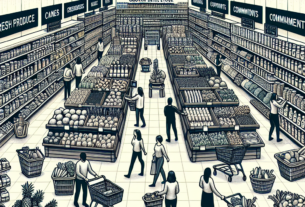The State of the Convenience Store Industry
Convenience stores have long been a staple in the retail industry, providing customers with quick and easy access to a variety of products. These stores typically operate 24 hours a day, seven days a week, making them a convenient option for consumers looking to make a quick purchase.
According to a report by CulinaryCoverage.com, the convenience store industry has experienced steady growth over the past few years. In 2025, the global convenience store market was valued at $1.2 trillion, with a projected annual growth rate of 5% over the next five years.
Market Share and Competition
Despite their convenience, convenience stores face stiff competition from supermarkets. Supermarkets offer a wider variety of products at lower prices, making them a popular choice for consumers looking to do their weekly grocery shopping.
In 2025, supermarkets accounted for 60% of the global grocery retail market, while convenience stores held a 20% market share. However, convenience stores have been able to carve out a niche for themselves by focusing on convenience and impulse purchases.
Financial Performance
In terms of financial performance, convenience stores have seen steady revenue growth over the past few years. In 2024, the average convenience store generated $1.5 million in revenue, with an average profit margin of 10%.
Supermarkets, on the other hand, had higher revenue numbers, with the average supermarket generating $10 million in revenue in 2024. However, supermarkets also operate on thinner profit margins, typically around 5%.
Strategies for Competing with Supermarkets
1. Focus on Convenience
Convenience stores differentiate themselves from supermarkets by offering quick and easy access to a limited selection of products. To compete with supermarkets, convenience stores must continue to focus on convenience and quick service.
For example, some convenience stores have implemented self-checkout kiosks to speed up the checkout process for customers. Others have introduced mobile ordering apps that allow customers to place orders ahead of time and pick them up in-store.
2. Offer Unique Products
Another way convenience stores can compete with supermarkets is by offering unique products that are not typically found in larger stores. These could include specialty snacks, locally sourced products, or niche items that cater to specific dietary preferences.
For example, some convenience stores have started carrying organic and natural products to appeal to health-conscious consumers. Others have partnered with local artisans to offer handcrafted goods that cannot be found in supermarkets.
3. Embrace Technology
Technology is playing an increasingly important role in the retail industry, and convenience stores must embrace new technologies to stay competitive with supermarkets. This could include implementing digital signage for promotions, using data analytics to optimize inventory management, or introducing contactless payment options for customers.
For example, some convenience stores have started using artificial intelligence to analyze customer data and personalize promotions based on individual preferences. Others have implemented loyalty programs that reward customers for frequent purchases.
Future Trends and Opportunities
Looking ahead, the convenience store industry is expected to continue to grow as consumers prioritize convenience and quick service. However, convenience stores will need to adapt to changing consumer preferences and embrace new technologies to stay competitive with supermarkets.
One emerging trend in the convenience store industry is the rise of ghost kitchens, which are commercial kitchens that prepare food for delivery only. Convenience stores have started partnering with ghost kitchens to offer a wider selection of food options to customers, expanding their appeal beyond just snacks and beverages.
Overall, convenience stores have a unique position in the retail industry, offering quick and easy access to a variety of products. By focusing on convenience, offering unique products, and embracing technology, convenience stores can continue to compete with supermarkets and thrive in the ever-changing retail landscape.



